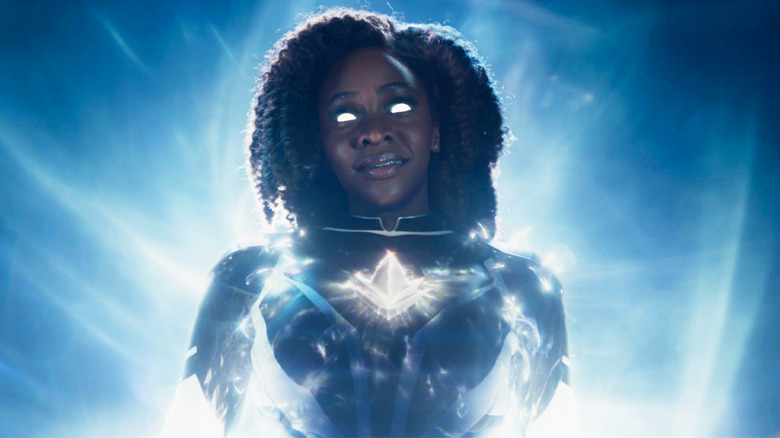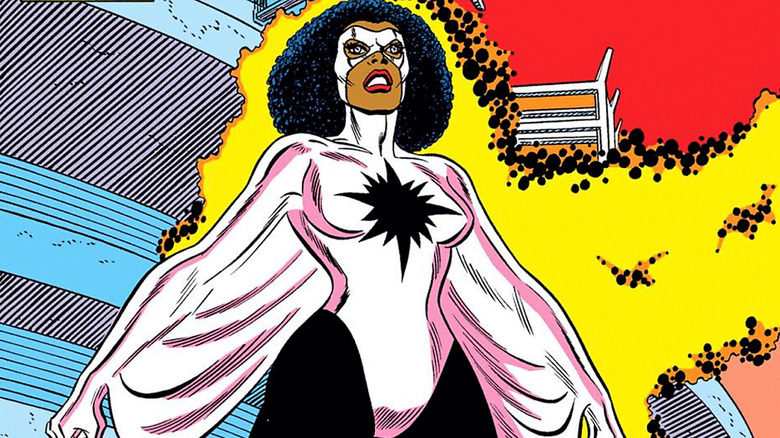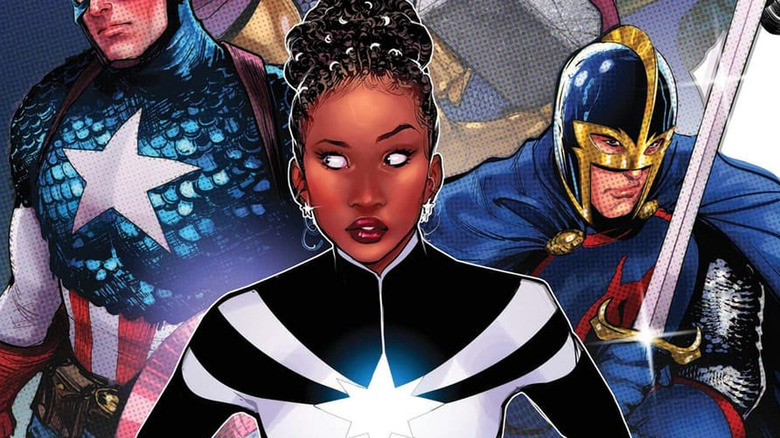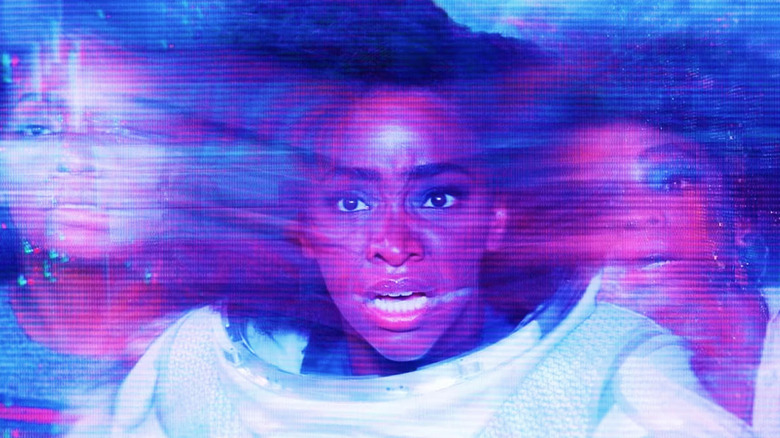The Marvels' Monica Rambeau Character Explained
One of the best running gags in "The Marvels" involves Monica Rambeau (Teyonah Parris) and the search for a perfect superhero name. Despite a fair amount of enthusiasm from Kamala Khan (Iman Vellani), whose own alter ego was not-so-subtly inspired by her obsession with Captain Marvel (Brie Larson), Monica is seemingly uninterested in that particular hero perk. By the end of "The Marvels," she's still just Monica Rambeau — despite powering up in a major way, saving the universe from an errant wormhole, and ending up in an entirely new timeline.
Monica's arc across the Marvel Cinematic Universe is pretty different from her peers, but it largely works to her benefit. In the comics, Monica is a superhero who's burned through a number of superhero nicknames. She's been called Photon, Spectrum, and even Captain Marvel throughout her tenure on the page — and her ever-changing role in the comics seems to have inspired her identity in the MCU. There's a chance that, soon, Monica will figure out exactly where she fits into the franchise. Until that day comes, though, let's look back at her history in the comics, from her original role as Captain Marvel to her tenure with the Avengers.
Monica Rambeau was Captain Marvel before it was cool
Monica was created by writer Roger Stern and artist John Romita, appearing first in "Amazing Spider-Man Annual" #16 in 1964. It's in this issue that Monica first harnessed her powers and became the superhero known as Captain Marvel ... almost 50 years before Carol Danvers inherited the mantle.
Born and raised in New Orleans, Monica actually possessed some power over the electromagnetic spectrum as a child. She suppressed those powers as she came of age, eventually forgetting that she ever possessed them. Her latent abilities would return in adulthood, in a manner not unlike Carol Danvers' MCU origin story.
Monica ascended the ranks at the New Orleans Harbor Patrol, a sort of maritime police force, becoming a lieutenant and angling for the role of captain. Sexist discrimination would prevent her from climbing the ladder, but fate had other plans anyway. Monica ultimately crossed paths with Professor André LeClare, an old friend of her grandfather's. He was on the hunt for an energy-draining device he'd built for the very evil Roxxon Oil Corporation.
Monica assisted LeClare in locating the weapon on a nearby oil rig — and in order to prevent Roxxon from using it for its own dubious goals, she destroyed the mechanism with her bare hands. That unlocked her suppressed powers anew, and Monica later learned that she could not only manipulate light but could transform herself into any form of energy on the electromagnetic spectrum.
Monica had an identity crisis in the Marvel comics
Monica quickly threw herself into the role of a career superhero. She took on her moniker, Captain Marvel, from a local newspaper, and promptly quit her day job to seek mentorship from a few established superheroes. With help from Spider-Man, the Fantastic Four, and Iron Man, Monica found a way to control the electromagnetic energy she'd inherited. She was recruited as an Avenger-in-training, quickly rising through the ranks — and assisting in a handful of intergalactic conflicts — to become a fully-fledged member, and later leader, of the superhero team.
The rest of Monica's tenure with the Avengers is full of ups and downs. She briefly lost her powers in a battle orchestrated by a rogue Avenger, Doctor Druid, and regained a semblance of them after a long recovery. But her role as a leader of the Avengers was undermined time and again — either by alien conflicts or good old-fashioned brainwashing. She'd even give up her original superhero moniker after a run-in with Genis-Vell, son of Mar-Vell (the original Captain Marvel). Genis-Vell would adopt the title to honor his father's legacy, while Monica took on the name Photon.
Monica has gone by many names in the comics — including Spectrum, Pulsar, and even her own given name. She's likely best known as Spectrum, as that's the title she's used as a member of the Mighty Avengers, Strikeforce, and the Ultimates. "Spectrum" also aligns pretty perfectly with the scope of her powers. That said, Monica's most recent solo comic has seen her revert to Photon.
Monica was reborn as Photon in 2022
"Monica Rambeau: Photon," released in 2022, brought the character into a new phase, retconning elements of her origin story that didn't make a lot of sense in the larger scheme. The five-issue series ends with Monica reconciling her previously fractured identity: it's effectively a blank slate for a character who's never really gotten the chance to stand on her own. Sure, she was a long-time leader of the Avengers and one of Marvel's oldest legacy characters. Before "Photon," though, Monica was rarely given the spotlight she deserved. Ewing effectively got to the core of who the character is and (hopefully) set the stage for more solo adventures in the future.
The Monica of the MCU also has her work cut out for her. 2019's "Captain Marvel" created an all-new origin story for the character, giving her a more personal connection with Carol Danvers. The MCU's Monica even gains her powers in a different way — a witch vortex in "WandaVision" — and while it makes for an interesting departure from the comics, it's not great that she's always more-or-less reliant on another character. Apart from a few key scenes in "The Marvels," we've yet to see Monica stand on her own. Whether the MCU can take a page from "Photon" and bring Monica into her own remains to be seen. Fortunately, her journey is just beginning — and it's already decidedly more streamlined than her comics counterpart's.



